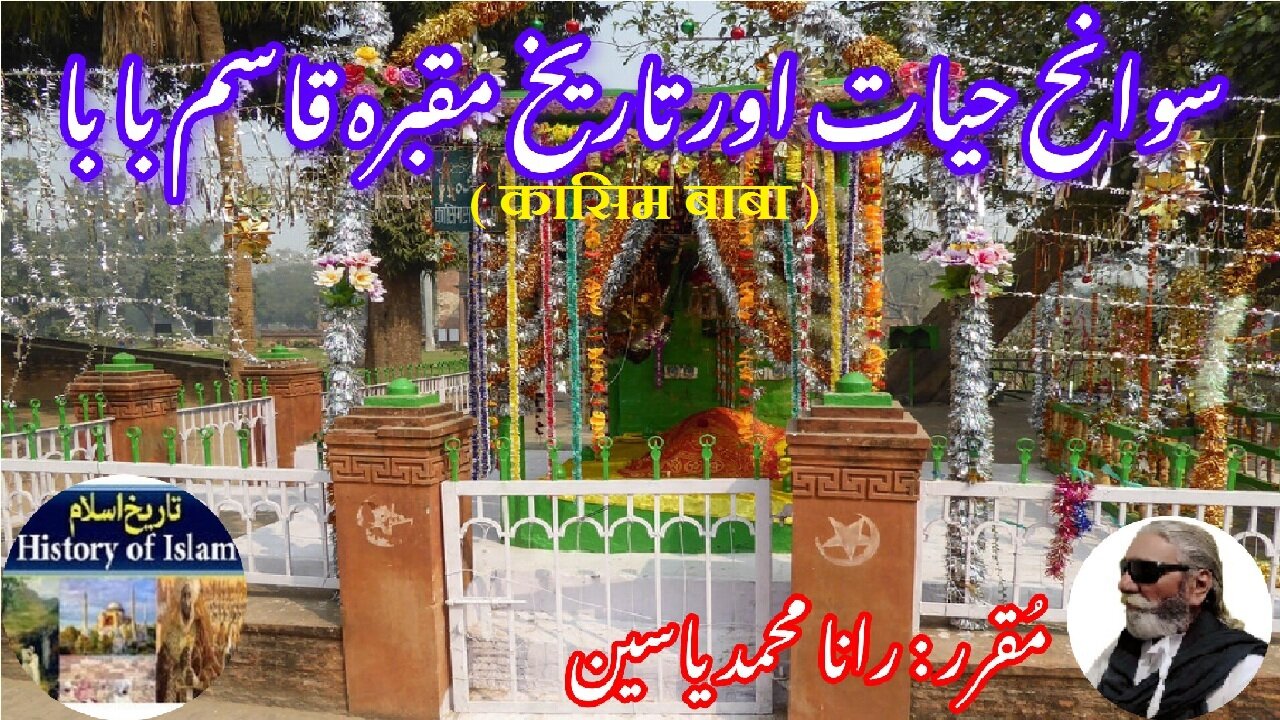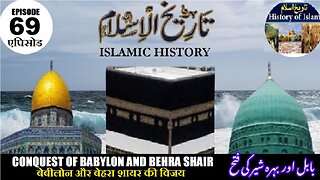Premium Only Content

Biography Qasim Baba कासिम बाबा قاسم بابا کی سوانح حیات اور ان کے مزار کی تاریخ
@islamichistory813 #sufisaint #culturalheritage #biography #kasimbaba #islamicmysticism #islamicphilosophy #shrine #historicalfigures
Biography of Kasim Baba and the history of his shrine
Dekhti Aankhooon aur sountay kaanoon ko Asslamoalaikum, sisters, brothers friends and elders, in informative series videos of Islamic ascolars, sufisaints, cultural heritages, islamic philosophys, islamic mysticisms and historical figures. today we are describing biography of Kasim Baba and the history of his shrine.
Kasim Baba, was a fifteenth century Bektashi religious figure and missionary. In Albania, he is venerated as a Muslim saint.
Kasim Baba was alive during the reign of Ottoman Sultan Mehmed II (1451-1481) and came to the Balkans where he was based in the Kastoria region. A Bektashi based history book written in the early twentieth century places the year of Kasim Baba's arrival to the Balkans at 1378. In his lifetime, he became renown for being a miracle worker. Kasim Baba converted lots of Christians into Muslims through unorthodox methods such as throwing a large rock from a hill toward a church with worshippers below in Kastoria. Legends associated with Kasim Baba is he visited Kuç, gave food to the dervishes at a spot by the cypress trees and later returned to Kastoria, and another of leaving his hand in the city of Elbasan.
A turbe (burial moment) and a Bektashi tekke dedicated to Kasim Baba were both located in Kastoria. An Ottoman register recorded the existence of the tekke (late sixteenth century). Ottoman traveller Evliya Çelebi visited Kastoria in 1661 and saw both the turbe and tekke which was located close to the Kastoria lake shore, among "some bushes". Later in the early twentieth century scholar Frederick William Hasluck visited Kastoria and described the tekke as "small, insignificant" staffed by one abbot in 1915 who had left by 1921. The turbe of Kasim Baba was located on a hill above Kastoria, later destroyed. The Bektashi tekke in Kastoria was also destroyed.
One of the earliest (Bektashi) tekke's built in Albania, the tekke of Baba Kasëm in Kuç, Devoll has him as its founder and his real grave is claimed to be based in the village. The Kuç tekke was destroyed (1826) by the Ottomans, rebuilt (1878), expanded (1906-1907), destroyed (1967) by villagers during the Albanian communist anti-religion campaign and rebuilt (1990s) post-communism. Close by in Kapshticë, Devoll, a tomb of Qazim Baba was a place of pilgrimage, with visits being of special significance on Monday and Friday.
The Bektashi order is said to have been founded in Anatolia by Haji Bektash Veli (Turk.Haci Bektas Veli) who lived in the thirteenth century. With the expansion of the Ottoman Empire, it spread from central Anatolia notably to the Balkans, Greece, Crete and elsewhere, where the Bektashi served as missionaries of Islam and chaplains to the janissaries. Little is known of the early history of the Bektashi in Albania though it can be assumed that they were well established by the late sixteenth to mid-seventeenth century. The Bektashi themselves trace their entry into Albania to the famous legendary figure Sari Salltëk. Turkish traveller Evliya Çelebi, who visited southern Albania in the summer of 1670, noted a Bektashi tekke in Kanina near Vlora, describing the site as follows:
”There is also a tekke of Haji Bektash Veli here, which was also endowed by Sinan Pasha. This tekke is famous throughout Turkey, Arabia and Persia. Here one finds many devotees of the mystical sciences and the dervish life of poverty. Among them are handsomeyoung boys. Visitors and pilgrims are fed copious meals from the kitchen and pantry of the tekkebecause all the surrounding mountains, vineyards and gardens belong to it. Near the tekke, thebenefactor of the endowment, Ghazi Sinan Pasha, lies buried along with all his household andretainers in a mausoleum with a lofty dome - may God have mercy on their souls. In short, it is arich and famous tekke, beyond my powers to describe” (Seyahatname VIII, 361a).
The mausoleum referred to by Evliya, now since disappeared, was still subject of veneration during the visit of Austrian consul Johann Georg von Hahn (1811-1869) in the mid-nineteenth century. Hahn reports: ”[The owners of the fortress] are descendants of the firstTurkish conqueror of this region, the famous Sinan Pasha of Konya, whose grave can be seen ina small tekke at the base of the castle. People come here on pilgrimage from far off, as the Turksconsider Sinan to be a saint.” The Bektashi tekke of Kanina was conferred upon the Halveti order when the Porte ordered the closure of all Bektashi tekkes in 1826.
Among other early Bektashi monasteries was the tekke in Tetovo (Macedonia), founded at the end of the sixteenth century. According to legend, Sersem Ali Dede, a vizier under Sultan
Suleyman (1520-1566), saw Bâlim Sultân, second pîr of the Bektashi order, in a dream and abandoned his post as vizier to become a dervish in the village of Haci Bektas, where the
Bektashi movement arose. Before his death in 1569, he ordered that all his possession be sold and that the money go to purchasing land for a monastery in Tetovo. The monastery was
constructed accordingly by one Harâbâtî (Harabti) Baba, after whom the tekke is named. This tekke was expanded in the late eighteenth and early nineteenth centuries to include a whole
complex of buildings and a beautiful garden, which still exist today as a hotel complex. From the early eighteenth century onwards, the tekke in Tetovo served as the mother house(asitane) formany other tekkes in Kosovo and Macedonia.
In 1780 followed the building of a Bektashi tekke in Gjirokastra under Asim Baba. This tekke laid the foundations for the Bektashi movement in Albania itself and was of particular
significance in the late nineteenth century. The Albanians were especially receptive to certainfeatures of Bektashism, namely its traditional tolerance and regard for different religions, and therelated open-minded attitude to practices and belief. Indeed some see Christian and pre-Christian practices continuing under the liberal umbrella of Bektashism. Furthermore, Bektashis were receptive to local concerns and language, in contrast to Sunni Islam, which was linked to the Ottoman capital and the Arabic language. Much of southern Albania and Epirus converted to Bektashism initially, however, due to the influence of Ali Pasha Tepelena (1759-1822), the awesome Lion of Janina, who was himself a follower of the order. The order suffered a setback
in Albania in 1826 when Sultan Mahmud II suppressed the janissary corp and ordered the closure of all Bektashi tekkes in the Ottoman Empire. The Bektashi were, nonetheless, prominent
once again during the years of the Albanian nationalist movement (Alb. Rilindja) in the late nineteenth century and it is this link, no doubt, which gave rise their surprising popularity. Such was the level of conversion to Bektashism that it grew into a religious community of its own and became the fourth religion of Albania.
It is estimated that at the beginning of the twentieth century, 15% of the population of Albanian were Bektashi, equivalent to one-quarter of all Moslems in the country. Their monasteries served as centres for the nationalist movement, in particular for the underground propagation of Albanian-language books and education. Despite this, the order did not succeed in becoming the Albanian national religion, as many Bektashi intellectuals had hoped. One reason for this was their disproportionate concentration in the south of the country (70% of all Bektashi tekkes were to be found south of Berat and only 3% in the north). In addition, Bektashism suffered a major setback with the revolt of many Moslems demanding the country’s return to the Ottoman Empire and, in particular, with the burning and looting of the Albanian tekkes by Greek extremists during the Balkan War and World War I. At that time, about 80% of the tekkes were damaged or destroyed completely, an immeasurable cultural loss from which this Islamic culture never really recovered. Nonetheless, during their first national congress, held in
Prishta in Skrapar in January 1922, the Bektashi declared themselves autonomous of the Turkish Bektashi, and after the ban on all dervish orders in Turkey in the autumn of 1925, it was to
Tirana that the Turkish Bektashi transferred their world headquarters. In Albania they set up a recognized and independent religious community which existed there until 1967. It was divided into six districts: Kruja with its centre at the tekke of Fushë Kruja, Elbasan with its headquarters at the tekke of Krasta, Korça with its headquarters at the tekke of Melçan, Gjirokastra with its headquarters at the tekke of Asim Baba, Prishta representing Berat and part of Përmet, and Vlora
with its headquarters at the tekke of Frashër. In 1928, Albanian publicist Teki Selenica recorded the presence of sixty-five babas, meaning theoretically that there were at least sixty-five tekkes in Albania. There were also about a dozen Bektashi tekkes in Kosovo. By the mid-1940s there were an estimated 280 babas and dervishes in Albania, and in the 1960s we know there were still about fifty Bektashi tekkes in the country and about eighty dervishes, fifteen in Fushë Kruja alone. By 1993, however, after the collapse of the dictatorship, there were only five babas and one dervish left alive, and only six tekkes were left standing in any recognizable state.
With this, we seek your permission until tomorrow, tomorrow we will describe the biography of Mawlana Khalid Baghdadi and the history of his Shrine. Allah Hafiz.
==================
-
 10:58
10:58
ISLAMIC HISTORY
6 hours agoIslamic History Episode 69 Conquest of Babylon, Behra Shair बेबीलोन की विजय بابل اور بہرہ شیر کی فتح
3 -

Kimberly Guilfoyle
2 hours agoBreaking News on China Tariffs, Plus Live with AJ Rice & Daniel Turner | Ep212
5.3K1 -
 LIVE
LIVE
Candace Show Podcast
1 hour agoBREAKING NEWS: I Know The Truth About Justin Bieber. | Candace Ep 175
5,848 watching -
 1:02:43
1:02:43
Michael Franzese
3 hours agoThis is EXACTLY How Mafia Infiltrated the NYPD for Nearly 2 Decades
13.6K3 -
 2:19:06
2:19:06
The Quartering
3 hours agoTrumps SAVE Act Passes, China Amazon Sellers PANIC, Russell Brand's Bad Take, & More
178K38 -
 11:47
11:47
Talk Nerdy Sports - The Ultimate Sports Betting Podcast
1 hour ago4/10/25 - "Game On: Tech Titans Unleash Secret Betting Formulas!"
2.48K -
 1:34:00
1:34:00
The Sage Steele Show
1 day agoMeghan McCain | The Sage Steele Show
10.7K5 -
 1:27:23
1:27:23
Russell Brand
4 hours agoThe Trans Con: How Did We Miss THIS?! – SF564
138K33 -
 LIVE
LIVE
The HotSeat
1 hour agoMinecraft Mania and Tim Poole’s Wild Take – What Is Happening?!
506 watching -
 LIVE
LIVE
Revenge of the Cis
2 hours agoEpisode 1472: Pocket Pool
1,056 watching